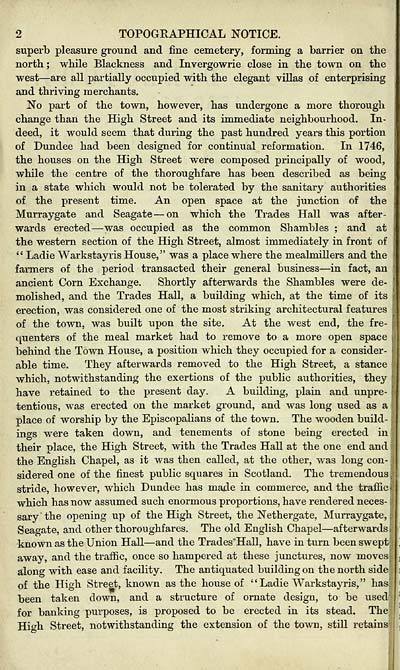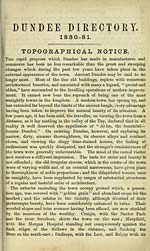Towns > Dundee > 1809-1912 - Dundee directory > 1880-1881
(24)
Download files
Complete book:
Individual page:
Thumbnail gallery: Grid view | List view

2 TOPOGRAPHICAL NOTICE.
superb pleasure ground and fine cemetery, forming a barrier on the
north ; while Blackness and Invergowrie close in the town on the
west — are all partially occupied with the elegant villas of enterprising
and thriving merchants.
No part of the town, however, has undergone a more thorough
change than the High Street and its immediate neighbourhood. In-
deed, it would seem that during the past hundred years this portion
of Dundee had been designed for continual reformation. In 1746,
the houses on the High Street were composed principally of wood,
while the centre of the thoroughfare has been described as being
in a state which would not be tolerated by the sanitary authorities
of the present time. An open space at the junction of the
Murray gate and Seagate — on which the Trades Hall was after-
wards erected — was occupied as the common Shambles ; and at
the western section of the High Street, almost immediately in front of
" Ladie Warkstayris House," was a place where the mealmillers and the
farmers of the period transacted their general business — in fact, an
ancient Corn Exchange. Shortly afterwards the Shambles were de-
molished, and the Trades Hall, a building which, at the time of its
erection, was considered one of the most striking architectural features
of the town, was built upon the site. At the west end, the fre-
quenters of the meal market had to remove to a more open space
behind the Town House, a position which they occupied for a consider-
able time. They afterwards removed to the High Street, a stance
which, notwithstanding the exertions of the public authorities, they
have retained to the present day. A building, plain and unpre-
tentious, was erected on the market ground, and was long used as a
place of worship by the Episcopalians of the town. The wooden build-
ings were taken down, and tenements of stone being erected in ji
their place, the High Street, with the Trades Hall at the one end and
the English Chapel, as it was then called, at the other, was long con-
sidered one of the finest public squares in Scotland. The tremendous i|
stride, however, which Dundee has made in commerce, and the traffic |
which has now assumed such enormous proportions, have rendered neces- j!
sary the opening up of the High Street, the Nethergate, Murraygate, j
Seagate, and other thoroughfares. The old English Chapel — afterwards i
known as the Union Hall — and the Trades' Hall, have in turn been swept-;
away, and the traffic, once so hampered at these junctures, now moves:
along with ease and facility. The antiquated building on the north side
of the High Street, known as the house of "Ladie Warkstayris," has
been taken down, and a structure of ornate design, to be used
for banking purposes, is proposed to be erected in its stead. The
High Street, notwithstanding the extension of the town, still retains!!
superb pleasure ground and fine cemetery, forming a barrier on the
north ; while Blackness and Invergowrie close in the town on the
west — are all partially occupied with the elegant villas of enterprising
and thriving merchants.
No part of the town, however, has undergone a more thorough
change than the High Street and its immediate neighbourhood. In-
deed, it would seem that during the past hundred years this portion
of Dundee had been designed for continual reformation. In 1746,
the houses on the High Street were composed principally of wood,
while the centre of the thoroughfare has been described as being
in a state which would not be tolerated by the sanitary authorities
of the present time. An open space at the junction of the
Murray gate and Seagate — on which the Trades Hall was after-
wards erected — was occupied as the common Shambles ; and at
the western section of the High Street, almost immediately in front of
" Ladie Warkstayris House," was a place where the mealmillers and the
farmers of the period transacted their general business — in fact, an
ancient Corn Exchange. Shortly afterwards the Shambles were de-
molished, and the Trades Hall, a building which, at the time of its
erection, was considered one of the most striking architectural features
of the town, was built upon the site. At the west end, the fre-
quenters of the meal market had to remove to a more open space
behind the Town House, a position which they occupied for a consider-
able time. They afterwards removed to the High Street, a stance
which, notwithstanding the exertions of the public authorities, they
have retained to the present day. A building, plain and unpre-
tentious, was erected on the market ground, and was long used as a
place of worship by the Episcopalians of the town. The wooden build-
ings were taken down, and tenements of stone being erected in ji
their place, the High Street, with the Trades Hall at the one end and
the English Chapel, as it was then called, at the other, was long con-
sidered one of the finest public squares in Scotland. The tremendous i|
stride, however, which Dundee has made in commerce, and the traffic |
which has now assumed such enormous proportions, have rendered neces- j!
sary the opening up of the High Street, the Nethergate, Murraygate, j
Seagate, and other thoroughfares. The old English Chapel — afterwards i
known as the Union Hall — and the Trades' Hall, have in turn been swept-;
away, and the traffic, once so hampered at these junctures, now moves:
along with ease and facility. The antiquated building on the north side
of the High Street, known as the house of "Ladie Warkstayris," has
been taken down, and a structure of ornate design, to be used
for banking purposes, is proposed to be erected in its stead. The
High Street, notwithstanding the extension of the town, still retains!!
Set display mode to: Large image | Transcription
Images and transcriptions on this page, including medium image downloads, may be used under the Creative Commons Attribution 4.0 International Licence unless otherwise stated. ![]()
| Scottish Post Office Directories > Towns > Dundee > Dundee directory > 1880-1881 > (24) |
|---|
| Permanent URL | https://digital.nls.uk/85898288 |
|---|
| Description | Imprint varies. |
|---|---|
| Shelfmark | Various |
| Description | Directories of individual Scottish towns and their suburbs. |
|---|
| Description | Around 700 Scottish directories published annually by the Post Office or private publishers between 1773 and 1911. Most of Scotland covered, with a focus on Edinburgh, Glasgow, Dundee and Aberdeen. Most volumes include a general directory (A-Z by surname), street directory (A-Z by street) and trade directory (A-Z by trade). |
|---|


